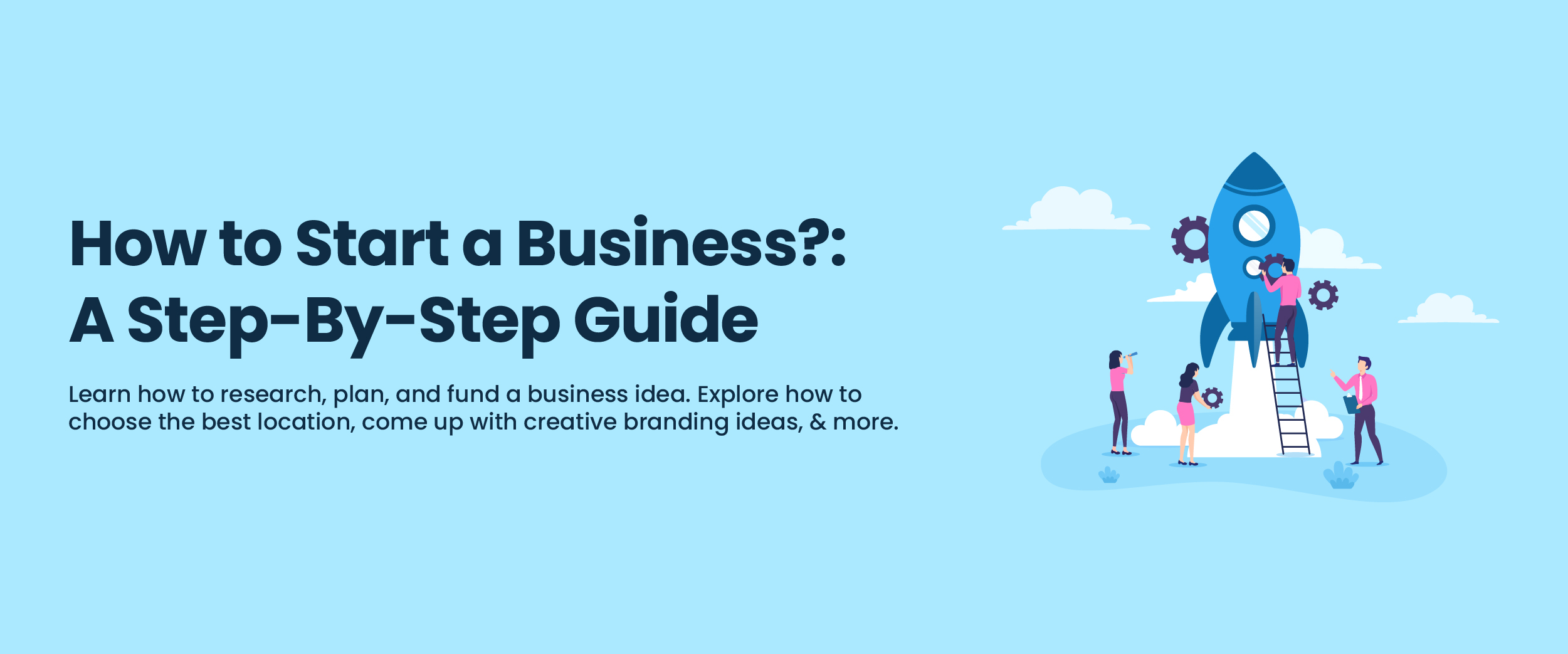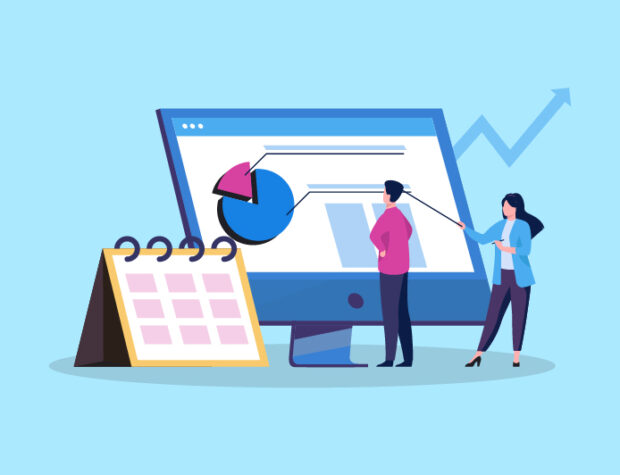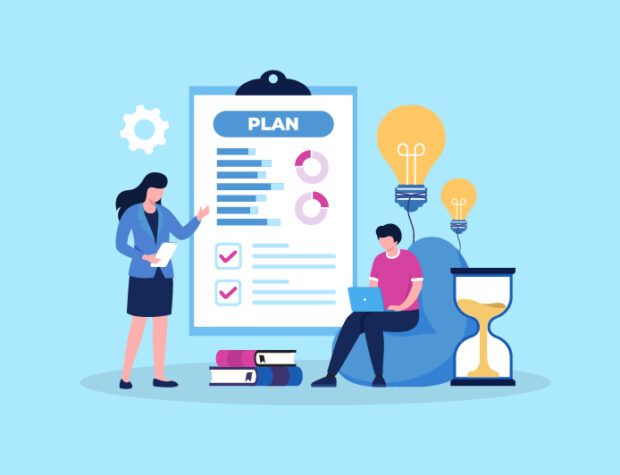How to Start a Business: Step-By-Step Guide

India has the third largest start-up ecosystem in the world and more than eighty-four thousand start-ups were recorded in the year 2022. If you aspire to own a start-up and seek guidance on how to initiate business, this blog offers a comprehensive step-by-step guide to help you start your own business venture and begin your entrepreneurial journey.
Here are fifteen steps that will help you understand how to start your own business. We discuss everything you need to get started, from business analytics and research to developing your business idea to launching the business. So let’s begin!
1. Determine Your Business Concept
Begin the development of your business concept or idea by identifying your strengths and analyzing if they have the potential to become a profitable business. Consider the following to create a business concept:
- Your Preferences: Ask yourself whether you want to work from home or an office, if you have the required skills, will the business be in a partnership, and how fast you want to scale the business. Depending on answers to these questions, select a product or service most suitable for your business.
- Research Existing Products: Research the product reviews of existing products and try to find possible gaps in the market. At times, instead of launching an entirely different product, you can take an existing one and improve or customize it to form a new product.
- Know What’s Trending: Keep a tab on popular or trending products. It can help you create a good business idea, especially if it is an online business.
Some popular business ideas are as follows:
- Online stores
- Blogs
- Franchises
- Clothing businesses
- Photography
- Copywriting services
- Dropshipping.
There are several other ideas that you can work on depending on your interests and goals.


2. Conduct Market Research
Once you have an idea or concept in mind about what your business would be selling, you can conduct market research. It is done to know what similar kinds of products and services exist, who your competitors are, potential problems you might face, and most importantly if there are customers who will be interested in buying your product.
Two types of research exist for this purpose. These are:
- Primary Research – It involves directly contacting potential customers through surveys, questionnaires, and interviews. Opinions and feedback can also be received through social media.
- Secondary Research – It involves analyzing data from already existing sources such as census and previous studies.
Other than the customers, you might also want to know about your competitors. Consider doing a SWOT analysis, that is, an analysis of the products:
- Strengths
- Weaknesses
- Opportunities
- Threats
Find out what products similar to yours exist in the market, what is their price, their unique selling point, the problems they face, and their pricing. It will help you improve your product or service.
3. Create Your Business Plan
A business plan is an essential component when learning how to start a small business. It helps in building the foundation of your business. It is a document often asked for by potential investors, company management, and financial institutions to understand your business. A good business plan includes the following sections:
- Executive Summary: It will provide information about your company, its vision, products and services, teams, employees, location, financial information, and growth plans in brief.
- Company Description: It will describe your company and the problem you aim to solve through your business in detail. Explain about the consumers and businesses you wish to cater to with your business. Additionally, specify how you have a competitive advantage over your competitors by describing your strengths.
- Market Analysis: It deals with comparative research. Here we mention the competitors and how they are performing in the market that we want to enter. The analysis can include the market we want to target, its scale and the trends that are followed.
- Organization and Structure of Business: It talks about the structure of your company and the management staff. It also outlines the legal structure of the company. You can opt for a corporation or an LLC (Limited Liability Company) among others.
- Products or Services: It will highlight the products or services you wish to offer through your business, how they will benefit the customers, and their lifecycle. Also, share plans about intellectual property and research and development.
- Marketing and Sales Plan: It will outline a plan for attracting customers for your business. Describe how you will promote your business, the budget for the marketing campaign, the period for the campaign, and the various sales strategies.
- Funding Request: It highlights your funding requirements. You will write how much funding you need and what you will use it for over a specified period. Also, include how you will be paying back any debt if taken.
- Financial Projections: It is a supplement to the previous one. Telling about your financial projections will help you portray a stable business. Write about the potential budget along with the income statement, balance sheet, and statement of cash flows.
- Appendix: It includes all the supporting documents such as credit histories, resumes, product pictures, letters of reference, patents, licenses, etc.
Your business plan should include an exit strategy. It highlights your plan of action if you ever decide to retire or move to other business ventures. Some common exit strategies are selling the business to other parties, transferring ownership to family members or board members, liquidating business assets, etc.
4. Secure Funding
Funding is something that everyone considers when wondering how to start their own business. There are two ways to fund your business, internal and external sources of funds. Internal sources of funds include personal savings, credit cards, and funds from friends and family. External sources of funds include the following:
- Business Loans
- Business Grants
- Investors
- Equipment Financing
- Crowdfunding
5. Develop Your Products or Services
Once you are done with your business plan and moving to secure the funding, think about the product or service you want to provide through your business. There are different ways to approach the product development. You can create your product by hiring a manufacturer and then selling it to the customers. Keep in mind the budget that you have or are willing to invest in the creation of the product.
There are now small businesses as well that run their business by customizing an existing product. An example of this is small-scale clothing brands printing t-shirts with their designs through online services.
Then some businesses curate a selection of products and do not create or customize it. It is known as a dropshipping business where one sells without having to manage an inventory.
6. Pick Your Business Location
The location of your business plays an integral role in attracting customers. Analyze your business plan and understand the kind of location that will suit your business the best. To decide whether you need a small workspace or an in-person retail space consider the following questions.
- How much space do you need for inventory?
- Will you be offering in-person retail services?
- Will you be packing and shipping orders from your location?
7. Choose Your Business Structure
It is important to decide on your business’s structure before registering it as the structure has a direct impact on legal aspects of the business such as taxes and liability. Various types of business structures are as follows:
8. Choose Your Business Name
A strong business name is not only different or unique but also short and simple. It is because you want your potential customers to remember it. Register your business name as either a trademark or a doing business as (DBA) name. If you are looking forward to an online presence of your business then you might want to consider registering a domain name or URL for the business.
9. Register Your Business and Get a License
Before your business begins its operations, you must register it with the government or the legal authority. The following are the documents that are necessary for or during the registration process.
- Article of Incorporation: The document includes the name of your business, its purpose, corporate structure, stock details, and other information. For LLCs, you will need to provide an operating agreement.
- Employer Identification Number: It is crucial to get an employee identification number to maintain separation between personal and corporate taxes when you hire employees.
- Income Tax Forms: Based on your business structure you will need to fill the various tax forms as specified by the government of your state or country.
- Licences and Permits: Based on the products and services there might be certain licenses or permits that you should have. For example, businesses selling medical equipment require a license whereas clothing brands selling t-shirts do not. Check with the competent authorities regarding the required licenses and permits and apply accordingly.
10. Understand and Order Your Finances
To run a successful business one should know about the key components of the finances and proceed only once they are in order.
- Get a Business Bank Account: Opening a business bank account is a necessity. It not only keeps your personal and professional finances separate but also is required when applying for a corporate loan from a bank. You will use this account for all things related to your business, be it paying the manufacturer or getting paid by the customers for the products and services.
- Manage Finances: The traditional way to manage finances is by hiring a bookkeeper. But since we are living in a digital age, so consider investing in accounting software. You can keep a record of your income and expenses with it along with calculating taxes and generating invoices.
For those wondering how to start a business in India, know that there are various GST or goods and services tax software available that provide services such as filing GST returns, uploading invoices, and creating challans for making payments.
- Determine Break-Even Point: To determine how much money you will need to start your business you can perform a break-even analysis. The break-even point indicates that profits are equal to the costs of a business. It is used to determine the profitability and price of the products or services.
You can calculate the break-even point by dividing the fixed costs by the contribution margin. It is suggested that you overestimate costs in the beginning to have much left at the end.
11. Purchase a Business Insurance Policy
It takes a lot of hard work, time, and money to start a business. Hence, you must protect it with an insurance policy. Some important insurance policies include General Liability Insurance, Business Income Insurance, etc.
12. Get the Right Business Tools
With the right business tools, you will be able to run your business smoothly. Some common business tools that you can consider for your business are CRM, Credit Card Processors, etc
13. Build Your Team
To begin your business operations and handle multiple tasks you might need a staff. Your team might include permanent employees, freelancers, contractors, etc. Some resources that you can use to find the right people for your business and build a team are hiring platforms, job boards, social media, job posting, and freelance platforms.
If there are budget constraints and you do not want to hire more employees then you can partner with other businesses in your industry. You can get into a partnership for either necessary services such as storage and shipping or complementary services such as a service that is in your niche but not similar to your service or product.
14. Market Your Business
Before you begin marketing your products and services, you will need to market your business. The more people know about your business the more they are likely to show interest in products provided by your business.
15. Launch Your Business
The final step is to launch your business. It is when you are ready with proper permits and licensing in place to open your business for the customers to engage with your products and services.
To boost your first-day sales and engagement you can always leverage your network, collaborate with other brands, and offer free products in exchange for promotion through other brands, etc.
Keep a tab on how the business is doing and customize your strategy accordingly to optimize your brand presence and customer experience.


Conclusion
Starting a business is never easy but with consistent steps, you can build a brand that reaches the target audience and is successful. The above-mentioned fifteen steps will help you understand how to start a business. With more research on legal requirements in your state or country, you are good to embark on your start-up journey.





